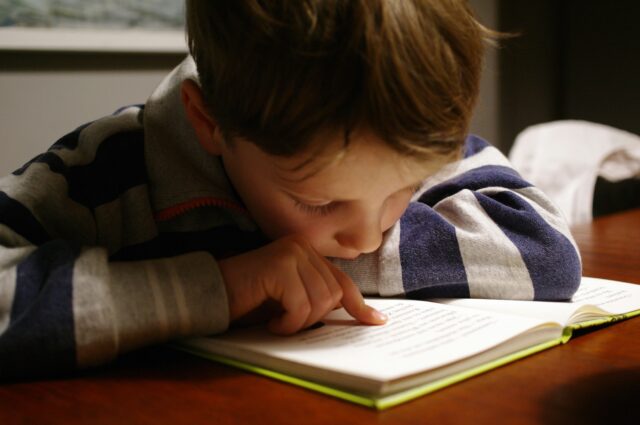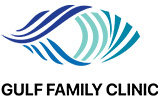Mon - Sat: 8:00 AM - 6:00 PM
Sunday: CLOSED
The Connection Between Vision and Learning
Vision plays a crucial role in children’s learning and development. Nearly 80% of what kids learn in school is processed visually. This includes tasks like reading, writing, understanding visual aids like charts and diagrams, participating in sports and other extracurricular activities.

Can vision problems cause learning problems?
Poor vision can significantly impact a child’s ability to learn and perform well at school. They may struggle to read what’s written on the board or in textbooks right in front of them, find it hard to stay on task for extended periods because of eye strain, or experience headaches and other physical discomforts. Such challenges can take a toll on children’s motivation to learn and their overall academic performance.
And though many schools offer periodic eyesight screenings, countless student vision problems still go undetected. This is mainly because these tests often focus only on distance vision, while most learning happens at a close reading distance. They also typically don’t assess the full range of visual skills children need for effective learning and reading.
As a result, a child may pass vision screening with flying colours and get 20/20 across the board, but still have an underlying vision issue like myopia (nearsightedness), hyperopia (farsightedness), astigmatism, binocular vision or other eye coordination or perception problems.
Conventional thinking can attribute a child’s struggles in school to laziness, lack of effort or learning disabilities such as dyslexia or ADHD, especially after ruling out student vision problems through a basic screening. However, complex vision issues could be the root cause all along.
For this reason, consistent student eye care through regular, comprehensive eye exams with a professional eye doctor is vital to identify and address any vision problems that may be hindering your child’s learning potential early on.
Give Your Child the Learning Edge – Book an Eye Screening Test Today
Frequently Asked Questions About Vision-Related Learning Issues
Hyperopia
What is hyperopia?
Hyperopia (farsightedness) is a common student vision problem where they can see distant objects clearly, but things up close appear blurry.
This happens when the cornea is not curved enough, the eyeball is too short, or the eye’s lens is too thin, causing light rays to focus behind the retina rather than on its surface. For children, it can lead to eye strain and fatigue since they have to work harder to focus on nearby objects.

How does hyperopia affect learning?
Hyperopia can influence a child’s ability to learn in several ways, including:
- Eyestrain, headaches and fatigue when focusing on objects up close, which can dampen their enthusiasm and confidence participating in activities like reading or writing.
- Difficulty reading materials in class, like books or written assignments, affecting their ability to learn and keep up with classmates.
- Behavioural and attentional issues in the classroom.
- With severe hyperopia, children may develop strabismus (misaligned eyes) or amblyopia (lazy eye), leading to double vision, depth perception problems and delayed developmental milestones.
How would you help a student with hyperopia?
Helping a student with hyperopia typically begins with a thorough eye exam, ideally performed between the ages of three and eight. A qualified paediatric ophthalmologist should assess the severity of hyperopia and recommend the appropriate course of treatment, which, for children, typically involves either eyeglasses, bifocal or multifocal lenses or contact lenses.
Dyslexia and the Visual System
Can dyslexia be fixed with vision therapy?
No, dyslexia can’t be directly fixed with vision therapy since it’s a learning disability that requires specific educational tutoring or counselling.
However, vision therapy can help alleviate some symptoms commonly associated with dyslexia, like tracking (difficulty scanning text) or convergence (the two eyes not working together properly) through a series of exercises or using devices like special lenses to boost eye muscle function.
What is one of the treatment methods for visual dyslexia?
One approach that may be helpful for some people with dyslexia is vision therapy, which entails training the eyes and brain to work together more effectively.
This can include performing exercises, using lenses or prisms and potentially wearing glasses full-time or just when reading (depending on the optometrist’s recommendations) to improve visual skills like eye coordination and movement control.
Do vision problems cause dyslexia?
No, dyslexia is a learning disability caused by differences in the brain’s anatomy and function or genetics, not visual impairments.
However, some student vision problems can manifest in similar ways as dyslexia, such as difficulty reading and processing written text. Since, as a parent, you may not be able to distinguish between the two, it’s important to have your child evaluated by a paediatric optometrist as soon as you notice any learning or reading difficulties to rule out potential vision issues.
Vision and ADHD
Does ADHD cause vision problems?
While there’s no direct evidence to suggest that ADHD causes vision problems, research has shown a correlation between the two. Children with ADHD may have an increased risk for certain visual conditions such as convergence insufficiency (difficulty coordinating the eyes to work together), poor focusing, astigmatism (irregularly shaped cornea/lens) and colour perception difficulties.
This doesn’t mean that all children with ADHD will have vision problems. Still, parents need to be aware of this potential connection and have their child’s eyesight checked regularly.
What are the symptoms of vision problems that can mimic ADHD?
Some reduced functional vision skills can lead to behaviours often mistaken for ADHD, such as:
- Difficulty with attention and concentration: Some student vision problems, like focusing issues or blurred vision can cause children to struggle with tasks, leading to frustration, fatigue, fidgetiness, giving up quickly or disruptive behaviour.
- Poor reading abilities: Eye tracking difficulties can make reading strenuous. Text lines may blur, leading to discomfort and slower reading speeds and causing the student to appear distracted and unfocused.
- Challenges with response: Difficulty processing and integrating visual input may hinder direct responses.
- Making careless mistakes: Eye strain or headaches can cause students to rush through work, missing details and making errors.
- Struggles in sports activities: Visual impairments can make it hard to judge distances, track objects and follow fast movements.
How can I tell if my child has ADHD or a vision problem?
If you’re unsure whether your child has ADHD or a vision problem, you should have them evaluated by a professional optometrist for functional vision problems. Many ADHD symptoms, like having difficulty reading, paying attention, appearing hyperactive and more could also stem from eyesight issues. An optometrist can accurately diagnose and treat any student vision problems contributing to these difficulties or at least rule them out as a probable cause.
Vision Therapy for Reading Fluency
What is reading fluency?
Reading fluency is the ability to read text with proper accuracy, speed and expression. This skill is essential in building reading stamina, especially for complex and lengthy texts. It also bridges the gap between recognising words and understanding their meaning.
Why doesn’t my child like to read?
There could be many reasons why a child may not enjoy reading. Some common ones include not finding a topic that interests them, feeling overwhelmed by the format or difficulty level of books, struggling with basic reading skills, or experiencing vision problems that make the activity hard or physically uncomfortable (headaches, eye strain, fatigue, etc.) for which professional student eye care might be necessary.
How does vision therapy improve reading skills?
Vision therapy enhances reading skills by targeting and strengthening specific abilities like eye coordination, visual perception, focusing and more through personalised therapeutic exercises and various aids and tools, such as lenses, prisms, patches, filters, balance boards or electronic targets. It addresses any neurological aspect of vision that may hinder efficient reading, making it a more comprehensive approach to student eye care than just using glasses or contacts.
Book a Comprehensive Eye Screening Test Today

Important Vision Skills for School
There’s more to vision than perfect 20/20 eyesight or seeing things clearly. For children to excel in school, they need to understand and respond to what they see. This requires a set of fundamental visual skills that are essential for academic success, including:
1. Visual acuity is seeing clearly in the distance, at an intermediate range and up close. It’s crucial for tasks like reading from a chalkboard, using a computer and reading books.
2. Eye tracking is the ability to keep your eyes on target when shifting your gaze from one object to another, like moving your eyes along a line of text while reading or following a moving ball in mid-air.
3. Eye teaming is the ability to coordinate both eyes when moving them along a printed page and to judge depth and distance accurately in activities like sports.
4. Eye focusing is when you can adjust the focus of your eyes to clearly see objects at different distances, such as looking from a book to a computer screen and back.
5. Hand-eye coordination is the ability to take in visual information, process it and use it to guide hand movements when hitting a ball, drawing a picture or any other activity that requires synchronising vision and movement.
6. Visual perception is being able to organise and interpret the images on a printed page, including letters, words and ideas. It also involves understanding and remembering what is read. Visual perception can involve additional skills like:
- Recognition: telling the difference between letters like “b” and “d.”
- Comprehension: creating a mental image of what is happening in a story while reading.
- Retention: remembering and recalling details from what was read.
7. Colour perception is accurately distinguishing between different colours.


Does My Child Have Vision-Related Learning Problems?
This checklist can help you identify if your child might have vision problems affecting their learning. It is recommended to consult an eye doctor for a comprehensive diagnosis.
Instructions: Please place a checkmark next to “Yes” for any behaviour you frequently observe in your child.

Testing for vision-related learning issues
If you’re a parent or guardian who suspects your child may have a vision-related learning problem, you should schedule an eye exam as soon as possible. During the exam, the paediatric optometrist or ophthalmologist will perform several tests to determine if there are any underlying vision issues that, if detected and treated, could potentially improve your child’s learning abilities. These may include screening for:
- Refractive errors (nearsightedness, farsightedness, astigmatism)
- Binocular vision problems (difficulty coordinating eye movements)
- Accommodative dysfunction (issues with focusing and maintaining clear vision)
- Amblyopia (lazy eye)
Additionally, if your doctor specialises in vision-related learning problems, they may run more extensive tests like visual memory testing, pencil/paper tasks, and perceptual screenings that assess your child’s reading efficiency and ability to copy forms accurately — all of which can provide great insights into your child’s vision abilities.
Treating vision-related learning issues
The type of student eye care required for vision-related learning problems will largely depend on the cause and severity of the issue your doctor uncovers. Here are a few of the treatment options they may recommend:
- Eyeglasses or contact lenses: If your child has a refractive error, they may need corrective lenses to help them see more clearly and comfortably. Your optometrist may also prescribe glasses or contacts for mild binocular vision problems or accommodative insufficiency.
- Patching or penalisation: For children with amblyopia or lazy eye, patching the dominant eye or using an eye drop to blur the vision in it can help strengthen the weaker one over time.
- Vision therapy: This is a specialised form of physical therapy for the eyes that aims to improve visual skills like eye teaming, focusing abilities and visual perception. It involves using personalised exercises, activities and, in some cases, aids like prisms, lenses, filters and other equipment to train the eyes and brain to work together more effectively.
Remember, early intervention is vital when treating vision-related learning issues. The sooner your child receives the appropriate treatment, the better their chances of improving their learning abilities and achieving academic success.

Take the first step in helping your child reach their full potential. Contact our team to schedule an appointment with our paediatric optometrist today.
View References >
The connection between vision and learning
https://www.cooperinstitute.org/blog/vision-and-learning-are-linked
Hyperopia
https://www.aao.org/eye-health/diseases/hyperopia-farsightedness
https://my.clevelandclinic.org/health/diseases/hyperopia-farsightedness
https://www.webmd.com/eye-health/farsightedness
https://my.clevelandclinic.org/health/diseases/hyperopia-farsightedness
Dyslexia
https://www.dyslexia.com/question/vision-therapy/
https://www.understood.org/en/articles/vision-therapy-and-dyslexia-what-you-need-to-know
https://dyslexiaida.org/do-vision-problems-cause-dyslexia/
https://www.allaboutvision.com/eye-care/parents-kids/dyslexia-and-vision/
ADHD
https://www.medicalnewstoday.com/articles/adhd-and-the-eyes#adhd-and-the-eyes
https://www.additudemag.com/adhd-and-vision-problems-understanding-symptoms/
Reading fluency
https://www.readingrockets.org/reading-101/reading-and-writing-basics/fluency
https://www.webmd.com/brain/what-is-reading-fluency
https://www.understood.org/en/articles/6-reasons-why-kids-refuse-to-read
Visual skills
https://www.aoa.org/healthy-eyes/eye-health-for-life/school-aged-vision?sso=y
Testing for vision-related learning issues
https://www.aao.org/eye-health/tips-prevention/learning-disabilities-vision
https://www.aoa.org/healthy-eyes/eye-and-vision-conditions/vision-related-learning-problems?sso=y


